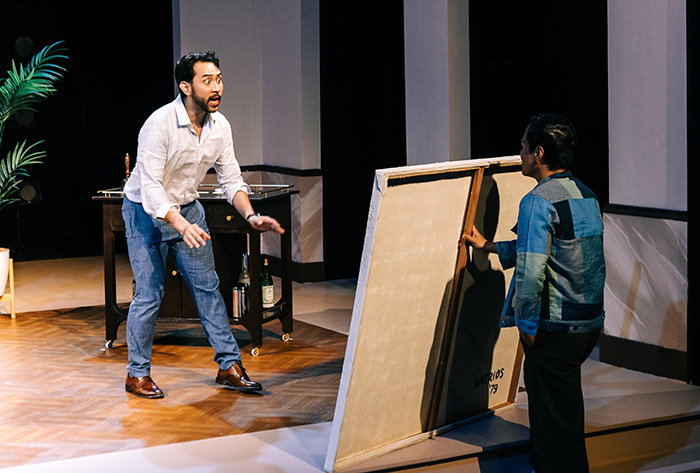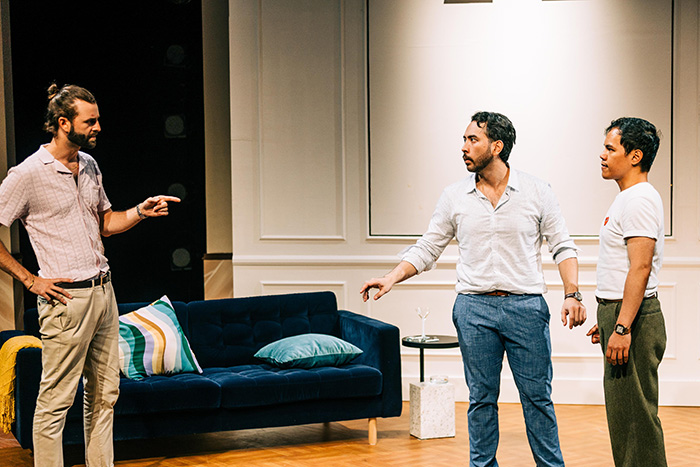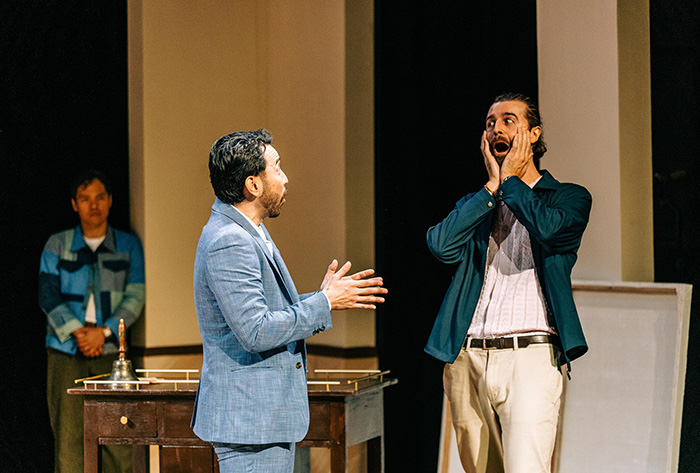REVIEW: REP’s revival of Yasmina Reza’s ‘Art’ is astonishingly propelled by its central trio
Over three decades since its premiere, French playwright Yasmina Reza’s acclaimed comedy Art, later translated by British playwright Christopher Hampton, is being revived by Repertory Philippines (REP) as the second production of the theater company’s 88th season. The Philippine restaging is directed by Victor Lirio, who helmed REP’s adaptation of Harold Pinter’s Betrayal last season.
The Olivier and Tony Award-winning play ran for eight years in the West End and over a year on Broadway, where it is set to return for the first time this year, beginning in late August through December.
For the curiously uninitiated, the chamber piece follows three longtime friends whose affinities for each other have been petering out way more than they’ve imagined. Serge, a dermatologist keen on modern art, purchases a 4-by-5-foot pristinely white painting by a fictional artist named Antrios, for 200,000 francs. Marc, a skeptical aeronautical engineer, can’t wrap his head around such an expensive acquisition, particularly from someone he’s known for 15 years. Marc detests the abstract purchase as though his friend just committed a cruel crime, which forces Yvan, a stationery businessman who’s already on edge for his forthcoming wedding, to act as a reconciliator between them.

The story is set in present-day Paris, propelled by English-speaking characters with British accents. Like the artwork at its center, the mounting of the play is also minimalist, with production designer Miguel Urbino opting for neat setups and a subdued stage palette. The beams and columns that give the impression of the Panthéon are lofty but unadorned, the costumes are smart casual, and the backdrop alterations are reduced to a minimum. Throughout the play, a bell functions as a device to signal the changes in character perspectives, paralleled by Miriam Crowe’s lighting, as the material is steeped chiefly in duologues and humorously timed soliloquies that break the fourth wall. The result is an astonishing comedy of manners within a lean context, with the play opening with a choreographed chase between the three characters.
The painting at the center of the play and the fracture that it’s caused between the three friends almost instantly brings to mind the internet frenzy engendered by the Comedian, the infamous conceptual art by Italian absurdist Maurizio Cattelan depicting a ripe banana duct-taped to a wall, which was exhibited at Art Basel Miami Beach in 2019 and valued at a shocking $120,000. Filipino audiences might also recall the controversy that surrounded actor Richard Gomez’s acrylic painting of a squirting phallus rendered in black and yellow. Tritely titled OOOOHH, the painting was featured at the public art exhibit ManilArt in 2019 and sold at P196,000.
Performed in over 30 languages, Art displays a broad appeal that makes it easy for the audience, regardless of culture and politics, to project their sensibilities onto the play. Though its central preoccupations definitely scream First World Problems, you could immediately sense the material working in the Filipino context, even as this adaptation, intent on putting its faith in the source text, eschews that route altogether.

The good thing is, it pulls it off so smoothly. The Parisian comedy is less about its central art piece than the intellectual, emotional, and political sensibilities that its white European male beholders attach to it. This is some sort of gaslighting ménage à trois that illustrates the swerving loyalties of its protagonists and forces them to think whether their bond ever existed past superficial terms. The material is not well-versed in the class undercurrents that shape cultural taste, precisely because Reza’s writing leans more on the power dynamics that inform long-term friendships, particularly of three men on the verge of a nervous breakdown.
Of the three characters, Yvan is the most evocative and least pretentious. He’s imperfect, conflict-avoidant to his own detriment, and can’t read the room at times, but he’s also the kind of person that’s there when needed, someone who simply believes in the good of the people around him, even as his closest friends describe him as an “amoeba” and a “coward.” Brian Sy, who last played Cassio in CAST PH’s Othello adaptation, locates Yvan in a kind of performance that oscillates between sweet and annoying, watchful and honest. A standout monologue about the vexing demands of Yvan’s carefully planned wedding affirms that Sy isn’t just the type of actor who could memorize his lines and is attuned to the beats of his character, but someone who could command a show on his own.

Meanwhile, it’s easy to mistake that Serge and Marc play foil to each other, when in fact, they are cut from the same cloth. Serge is self-indulgent and loves to throw out terms like “deconstruction,” “incredibly modern,” and “read Seneca,” with an air of condescension, as though it equates to having a personality. Marc is a raging contrarian who sees his friends only as a validation of himself: his status, his ideas, his taste. Serge is just as obnoxious and posturing as Marc, as both of them think that being vulnerable with each other is a mortal sin. And it’s so fascinating to witness this intellectual one-upmanship between the two because of the incredible prowess of the actors behind them.
Martin Sarreal, currently seen as Lord Barnell in the third season of the Netflix series Bridgerton, portrays Serge’s domineering attitude through his perfect enunciation and dexterity; he’s able to create a spectacle out of the simplest of gestures, like waving away cigarette smoke. At the same time, British screen and stage actor Freddy Sawyer imbues his portrayal of Marc with a towering presence not just because of his height but the intimidation that his posture expresses, with limbs that are often crossed and a resting bitch face; he’s annoyingly terrific.
But beyond these performances motoring the show, Art works as a comedy because it is sarcastically funny. The humor is largely British, and it’s not slapstick, but hilarious all the same. Though there is a formula at play, you could not sense that in the way Lirio and his actors draw out every ounce of levity from the material and so timely punctuate tense moments with snappy, facetious confessionals. Cases in point: when Serge tells Marc that he’s not getting on his nerves, then suddenly breaks the fourth wall and admits that his mate is in fact getting on his nerves; when Marc sardonically says “You can’t hate what’s invisible, you can’t hate nothing,” as he decries the all-white painting; or when Sy simply declares “Yvan returns!”
But it’s important to emphasize that Reza’s text doesn’t really immerse us in the specific corners of this 15-year friendship and how it has evolved. Any background the material provides chiefly functions as inciting details meant to stretch and heighten the tension at hand. It is, of course, by design, and Lirio is certainly up to the task. He mines wonders within the constrained context of the play. And unlike its characters, Art doesn’t pretend to be what it is not. Whatever it says about art isn’t something that hasn’t been articulated before; I don’t think that is the point. If anything, it is a stinging look at the absurd ways in which we wrestle with our impossible selves.
Art will run from June 13 to 29 at the REP Eastwood Theater in Quezon City.


